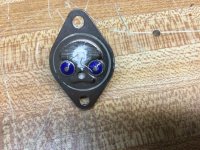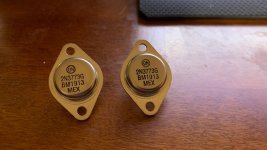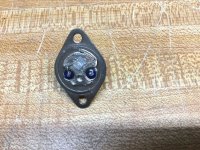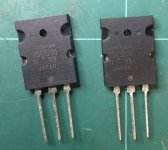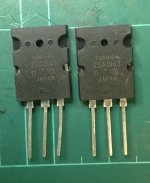PROFUSION is the right delivery source for genuine SANKEN power devices, because the guys tells me, that which is ordered here directly from SANKEN.
Which company resp. supplier guarantees this regarding power devices from OnSemi (formerly Motorola) and Fairchild ?
This is important to know, because there are in the meantime an extrem wide range of companies, who offer copies and counterfeits with exact the same outline than the genuine parts.
The area when you normally order such parts after comparing prices are long gone.
Which company resp. supplier guarantees this regarding power devices from OnSemi (formerly Motorola) and Fairchild ?
This is important to know, because there are in the meantime an extrem wide range of companies, who offer copies and counterfeits with exact the same outline than the genuine parts.
The area when you normally order such parts after comparing prices are long gone.
PROFUSION is the right delivery source for genuine SANKEN power devices, because the guys tells me, that which is ordered here directly from SANKEN.
.
I’m sure it was Profusion who bought up ALL the remaining Sanken MT200 stock in the world when they announced EOL. They went quick and they were gone, except a few odd lots of one polarity only which lingered for a while.
When the Sanyo parts that ON acquired went EOL at least I had rime to get mine bought before they vanished. I keep tabs on this on a much more regular basis now.
Mah .... But the dimensions of the wafer seem correct! Fakes usually have a very small wafer .....
Exactly. I had another fake MJ15024 from the same batch, marked with the same date code, supposedly from MEXICO - spelled right- that looked like this inside. It’s *almost* the right size. The die is a 2N5630 - they have a very distinct layout that’s easy to recognize if you’ve seen them before. Probably a genuine Motorola they acquired from somewhere, or maybe one of the second sources now making those dies and selling them under Mospec, Central, or Solid State(part of NTE group).
Now you put those two in parallel, and wonder why the thing won’t bias cleanly and the voltage on the emitter resistors is way different despite being “from the same batch”. That’s what clued me in to the fakes. The amp was actually *working*. Would have blown up eventually, though.
Attachments
The sorcerers apprentice at work. Don't judge him too hard. He surely will improve his skills.
These are currently on offer on Fleabay.
.Matched Quad 405 Replacement 2n3773 Transistors,best quality ever | eBay
The 2N3773 is still commonly available.
But people still like to pay less than $7 apiece for them. So the black market continues.
I don't want to drag this thread off topic with the very closely related issue of fake op-amps so if you are interested (and especially if you have bought AD797) please take a quick look over here at this new thread: *Thousands Sold*, Great Reviews... Received Fake AD797 Like LM741. Did You Buy These?
It was fake. If it looks like fake, doesn't have datasheet, has non-standart case and parameters, so the conclusion is one.Interesting. Please ask on your delivery source (ordering address), from where they in turn bought the ROHM copies.
For this ROHM transistors I use as replacement parts such from SANKEN (2SA1294/2SC3263, order on Profusion). Your image I have upload here, because on imgur.com the image was delete someday.
Under "PMC" I have found this:
PMC-Sierra - Wikipedia
but I don't think, that is the company makes the ROHM copies.
Check out also this URL:
bipolar (bjt) transistor families for audio power output stages
I returned it to seller with reason "not match datasheet". They bought parts from different suppliers and sometimes there are fakes
Finally I bought on ebay (Radio-antiqua) original ROHM transistor. It 100% looks like my samples and have same hfe.
There was also an attempt to buy it from Utsource, but they stopped supplying some parts to my country.
Fake 2sc5200 and 2sa1943 ?
Hi all
After blowing up 8 of these transistors in my attempt to repair a Denon PMA-700v I am starting to suspect they are fakes. They seem to work up to about 10Vrms after which time they blow. Yes, I got them on Ebay but from a local Australian seller so I thought that would improve my odds. Thoughts ? The offset print on one of the 2sc5200's looks dodgy. I really don't know how else to check them. It still could be my repair job.
Richard
Hi all
After blowing up 8 of these transistors in my attempt to repair a Denon PMA-700v I am starting to suspect they are fakes. They seem to work up to about 10Vrms after which time they blow. Yes, I got them on Ebay but from a local Australian seller so I thought that would improve my odds. Thoughts ? The offset print on one of the 2sc5200's looks dodgy. I really don't know how else to check them. It still could be my repair job.
Richard
Attachments
Hi Richard. I also had the same problem with these transistors. They exploded !! Over the years I have understood that today it is not easy to judge a component by the writing! The fackers have reached very high levels in the printing of the abbreviations and also in the materials of the package. This makes it very difficult to verify by eye. There are 2 solutions to check if a component is original or fake: 1) the bench test verifies that the measurements taken, especially the maximum voltage and current, correspond to the data in the manufacturer's datascheet. (This case, however, still requires you to purchase the component). 2) buy only from official sellers. (RS components, TME, Farnell, Arrow ..... etc.). I don't even trust physical stores in my city anymore! I hope to be proved helpful.
- Home
- Design & Build
- Parts
- My Transistors, original or copy?
